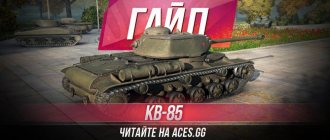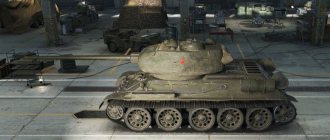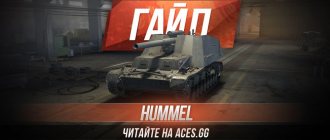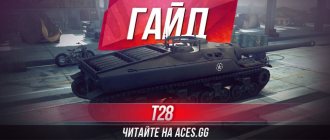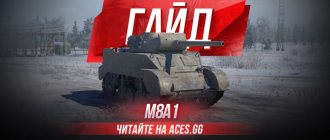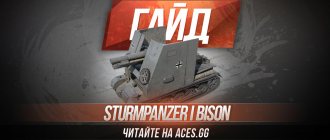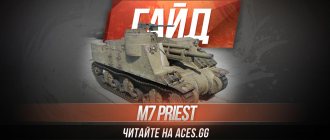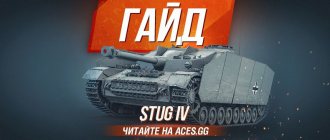Good day everyone and welcome to aces.gg! Friends, now we will talk about a very comfortable and strong car, the favorite tank of many players, an American tank destroyer of the sixth level - this is the M18 Hellcat guide
.
Once upon a time, this device was a fierce imba, everyone adored it, however, in the distant patch 0.9.3, our representative of the cat family was nerfed, but the M18 Hellcat World of Tanks
still remains a very worthy self-propelled gun, its characteristics are worthy of respect, so let's look at them in detail.
Research tree
The amounts are not significant, and experience on this machine accumulates very quickly, so I think there will be no problems with fast leveling.
As always, you need to research first. The top one will add carrying capacity for us to install more advanced modules.
With such a low weight, the top-end engine significantly improves our driving performance. The chance of fire is standard, but we rarely burn.
The stock radio station does not give us enough to play successfully, so it is necessary to open a top-end or pre-top radio as soon as possible.
The top tower does not add to our visibility. The turning speed also remains the same, but it will add HP and allow you to install a top weapon. I will also note that her booking is much better.
The choice of weapons is quite large, but in the end you will ride with the top one. It has good penetration for its level, excellent accuracy and rate of fire.
results
Already at the shooting range, the Ase Utra SL7 sound moderator was screwed onto the barrel of the carbine. It’s surprising to hear statements that, they say, a sound moderator is not needed for hunting tasks. How necessary! And we’re not just talking about the safety of the animals’ nerves - what’s much more critical is that irreparable damage to your hearing can be caused by a single shot. In addition, as a result of many years of experience, we are convinced that the correct sound moderator in most cases also improves the accuracy of the rifle.
M15x1 muzzle thread allows the use of sound moderators or other muzzle devices
We take a position at the shooting table, the Mauser M18 is placed on the front and rear rests. Approximate aiming through the barrel, firing, making adjustments (the click price of the sight is 1/4 MOA), test shot - done. Even during a short shooting, it was possible to evaluate the excellent performance of the single-stage trigger. By the way, the trigger force is adjustable from 1,000 g to 1,500 g using an easily accessible hexagon - but the preset value is quite suitable for us. There was also a chance to feel how well the rubber butt pad softens the recoil of a light (only 4.1 kg with rail, rings, sight and cartridges) carbine - it softens it, and quite efficiently.
Go! Test firing from the carbine was carried out at a distance of 100 m by two shooters: the first shot from a sitting position with the carbine fore-end resting on the bag and the fist under the butt, the second - from a Harris bipod and rear bag mounted on the base of the swivel on the fore-end. The shooting was carried out in series of five shots, with breaks to cool the barrel and muffler. To evaluate the results, the average value was derived from the indicators of two shooters.
The best accuracy was shown by the RWS cartridges with the heaviest Evolution bullet - groups of both shooters were less than 1 MOA (average value - 0.83 MOA). In second place is Geco TM/Softpoint with an average result of 1.1 MOA, in third place is Geco Express (the lightest of the bullets) with an average value of 1.29 MOA. Thus, in the most unfortunate case, five bullets still fit in a circle with a diameter of less than 4 cm! To summarize: the combination of our carbine with each of the tested cartridges is more than sufficient to solve hunting problems. Moreover, if the M18 demonstrates an accuracy of less than 1 MOA with randomly taken hunting bullets, then when selecting ammunition you can achieve much more from it.
Ammo used for the test and the best groups (from left to right): RWS Evolution, Geco TM/Softpoint, Geco Express
To summarize, we can confidently recommend the Mauser M18 to those who do not want to dance with a tambourine on fine-tuning a weapon, but are looking for an inexpensive, accurate, reliable and unpretentious hunting carbine. In addition to all of the above, this carbine proudly bears the name Mauser, which is magical to the ears of every hunter and shooter. But it is known that whatever you name the yacht, that’s how it will sail.
Nikolay Dmitriev
Leveling up
There are two options for researching modules on the M18 Hellcat. Let's look at each of them.
When switching from T49:
- we install a top-end Wright Continental R-975C4 engine, a top-end SCR 619 radio and a 76 mm AT Gun M1A1 gun
- then we examine the chassis
- after that we will examine the pre-top gun 76 mm AT Gun M1A2
- Next comes the M18 M1 tower
- and the long-awaited top gun 90 mm AT Gun M3
When upgrading from M10 Wolverine:
- install the researched Wright Continental R-975C1 engine and 76 mm AT Gun M1A2 gun
- then the walkie-talkie
- then we install the chassis
- next we change the tower
- We finally get the top gun 90 mm AT Gun M3
- Well, for dessert we have the top-end radio SCR 619
Notes[edit]
- torsion bar suspension was used for two other late war American tanks, the M24 Light Tank and the M26 Pershing.
- Collateral (2004)
- Jose, Cosme; Ranu, Jeff; Spickert-Fulton, Sean. "The M1A1 AND M1A2 76MM GUN: AN ANALYSIS OF US ANTI-TANK CAPABILITIES DURING WORLD WAR II" (PDF). Defense Technical Information Center
. clause 7. Retrieved October 22, 2022. - https://afvdb.50megs.com/usa/m18hellcat.html
- Collateral, Stephen J, M18 Hellcat SPG 1943-97
, p. 14, ISBN 1-84176-687-9 - "4: M18 Hellcat". Overhaul of the tank. Episode 1. August 13, 2008 Military Channel.
- Patton Vanguard: US Army Fourth Armored Division
, Don M. Fox. Page 25 - Zaloga 2004, page 5
- Zaloga 2002, p. 13
- Zaloga 2002, p. 19
- Hunnicutt 1992, p. 298
- ^ ab Chamberlain and Ellis (1969) p147
- Don M. Fox Patton Vanguard: US Army Fourth Armored Division
p.26 - Collateral, Stephen (2008). Armored Thunderbolt
. Stackpole. paragraph 194. - Jentz, Thomas (1995). German tank "Panther"
. Schiffer. paragraph 127. - Weapons Tankers Harry Yeide. P61.
- Bird, Lorrin; Livingston, Robert (2001). Ballistics of World War II: Armor and Artillery
. Excellent match. paragraph 63. - Zaloga 2004, page 12
- "Section III-A Artillery - General Supplies", Lend-Lease Supply Quantities
, War Department, p. 9 November 1946 - via HyperWar Foundation - Doyle (2012) p36
- ^ a b Doyle (2012) p57
- ^ a b Pledge (2004) p. 44
- ^ a b Doyle (2012) p22
- Collateral (2004) p12
- Zaloga 2004 p34
- Zaloga 2004 p36
- Zaloga 2004 p37
- "Tank Action" by George Soroka P195. ISBN 0-7509-0479-8
- ↑
Military Channel,
Tank Overhaul
, "The Hellcat" (2006), aired October 5, 2007, 10:00 a.m. Moscow time. - ^ abcdefg Military Channel, Program "Tank Overhaul" 22:51, Wednesday, August 13, 2008 (UTC) "The Current Hour EDST", a documentary mixed with interviews with WWII veterans.
- "M18 Gun Motor Carriage (Hellcat) Tank Destroyer (TD) / Gun Motor Carriage (GMC) - United States". www.mmilitaryfactory.com
. - “Tank tactics: from Normandy to Lorraine” by Roman Yarimovich, ch. 5 Creation of North American tank armies
- Kočevar, Iztok (August 2014). "Micmac à tire-larigot chez Tito: L'arme blindée yougoslave durant la Guerre froide" [The Yugoslav Armored Arm during the Cold War]. Batailles et Blindés
(in French). No. 62. Caraktère. pp. 66–79. ISSN 1765-0828. - ↑
Radic, Aleksandar (February 15, 2008).
"History - Kraina Express". Arsenal Magazine
(in Serbian) (14): 51–54. Archived from the original on September 4, 2012. Retrieved January 20, 2015. - <General Staff / Training Directorate of the Greek Army (Γενικό Επιτελείο Στρατού / Διεύθυνση Εκπαιδεύσεως), History of the Cavalry and Tank Corps (Ισ τορία Ιππικορανα, 1995, Athens)
- https://grvehicles.wordpress.com/2015/07/06/m18-hellcat/
- "Archival copy". Archived from the original on 2017-09-05. Retrieved 15 April 2022 .CS1 maint: archived copy as title (link)
- Stephen J Collateral, M18 Hellcat SPG 1943-97
, pp. 11-12. ISBN 1-84176-687-9 - Deposit p. 43.
- Tankograd Militarfahrzeug Spezial No 5002 “Die Anfangsjahre des Heeres 1956-1966 (the first years of the modern German army)” Peter Blum PP48-49. No ISBN number
- ↑
Stephen J. Zaloga (March 20, 2013). Tank destroyer M18 Hellcat 1943–97. Bloomsbury Publishing. paragraph 68. ISBN 978-1-4728-0308-5.
Advantages and disadvantages of the car in the top configuration
pros
- Presence of a tower
- One of the highest maximum speeds in the game – 72 km/h
- Excellent elevation angles
- Small dimensions = high level of stealth
- A gun with a high DPM, good accuracy and fast aiming
- Good review
Minuses
- Very weak armor (even the first levels can penetrate us)
- Low traverse speed of the turret and chassis
Tactics
The M18 Hellcat is one of those vehicles where mindless play gets the tanker a free pass to the hangar. Many players, having received the opportunity, in the literal sense of the word, to “fly” on this tank destroyer (with its maximum speed), thoughtlessly drive to the first line of battle and, shouting “OLOLO OTAKE PYSHPISH”, die in the first minutes of the battle, without inflicting damage. there's no damage to it. We must understand that such a high speed (with such poor maneuverability) is given to us not for a “rush” or “primary exposure”, but for prompt access to key positions of tank destroyers and for the ability to quickly change the flank if necessary. The ideal position for the M18 Hellcat is a point that will hide us behind a bush and give us the best possible view of the map. The standard combat technique is the following algorithm:
- standing in the bushes we make light (using a stereo tube)
- we drive 15 meters away from these same bushes
- we shoot illuminated enemies
- repeat “until ready”
You should also always remember that you DO NOT HAVE A RESERVATION. None and nowhere (you shouldn’t count on the gun mantlet - non-penetration and ricochets from it will be a pure coincidence, rather than some kind of pattern). So it’s always better not to get one shot from some KVAS (almost all of our health) than to cause him extra damage yourself. In short, you can achieve good results on this machine by adhering to the following fairly simple rules:
- we play in the style of a PT hunter (playing from the bush)
- We always play as if we have 0 armor and 1 HP
- We make the most of tactical advantages due to our high speed and high stealth
Katinka also made me smile very much:
I think this will be a warning to you =)
Stories about weapons. M18 Hellcat
The history of world tank building, and indeed military equipment in general, is replete with many amazing events. Events that, according to the logic of things, should not have happened, but for some reason history made it so that these events happened and even became, to some extent, turning points.
A vehicle that was initially made as an auxiliary vehicle and did not put any revolutionary solutions into it suddenly becomes the favorite vehicle of soldiers. And vice versa, truly outstanding designs, which at the time of their creation were a real breakthrough, disappeared as unnecessary at a specific time, and then turned into the basis for completely new objects.
There are several cars in our stash that were not supplied to us under Lend-Lease, but were loved in those countries where they were used during the Second World War. We couldn’t miss the opportunity to touch, tug, and get under the bottom. Well, even more so, they couldn’t help but talk about these cars.
In short, the series about self-propelled guns is a logical continuation of our series about foreign vehicles from the Second World War, which, for various reasons, our tank crews and artillerymen did not have the chance to meet. And the first vehicle will be the M18 “Hell Cat”, which successfully hunted enemy tanks and other armored vehicles. So, 76-mm Gun Motor Carriage M18, Hellcat.
The Hellcat, according to most experts, was one of the best tank destroyers of World War II. The low silhouette, high power density, high mobility, rational form of armor, high reliability and well-made suspension made it possible to achieve victories over the enemy with relatively small losses.
Simply put, the car was so balanced that, probably, there was no crew who did not cherish their “cat” no worse than the pet after which the car was named. Almost every self-propelled gun had its own name and even its own “coat of arms”. The machine responded to love with love. In the figurative sense of the word.
This, for example, is the emblem on “our” copy. “Double problems” that should not scare real fighters. Moreover, the crew of the “Hell Cat” will not be scared by some hot girls and cold whiskey.
But let's return to the self-propelled gun.
The history of the creation of the car is so interesting that it is impossible not to tell it. Let's start with the fact that American paratroopers and marines are to blame for the appearance of this self-propelled gun! Yes, although it sounds surprising.
We often argue that the USSR and Stalin personally delayed the war with Germany in every possible way. We are trying to explain Stalin's mistakes, unpreparedness for war, and the losses of the first months. We argue until we are hoarse. We tear the vests on the chest.
But let's look across the ocean. The Americans did not want to fight against fascism in Europe so much that they did not even declare war on Hitler! But Washington understood that they would have to fight. There was only one question: whose side. To be in time for the division of trophies. Hitler himself gave the answer. It was he who declared war on the United States.
The American military demanded that the army be re-equipped to fight a war far from its country. The ocean was and still is a fairly good defense for the continental States. That is why the task was first set to rearm the mobile units. Marines and airborne units.
In conditions where landing should be carried out not on islands, where the use of ground armored vehicles is limited, but on the continent, the question arose about the possibility of marines and paratroopers countering armored vehicles, primarily enemy tanks. And it’s even better if the mobile units get a good tank of their own!
In 1941, a competition was announced to create a tank for paratroopers. A tank that would combine the capabilities of transportation not only by ships, but also by planes. And at the same time he was able to fight with enemy tanks. Tank projects were presented by three companies - GMC, Marmon-Herrington and Kristi.
Strange as it may sound, the competition was won by an unknown person who had previously produced only two tank models (CTLS and CTLB), by the way, both failures, Marmon-Herrington. By the end of September, the T9 tank project was ready, and the start of serial production was expected.
And then something happened that turned the whole project in a completely unpredictable direction. The Marmon-Herrington engineers and designers who developed the new tank proposed creating an SPG on the same base. To support tanks. Only it was proposed to equip the self-propelled guns with the same chassis, approximately the same turret and the same gun! It looks crazy, but it's a fact.
However, this nonsense still had its continuation. The United States did not have light self-propelled guns. The army was simply forced to consider this project as promising. The only thing that the military department managed to do was remove the requirement for self-propelled guns as airborne units. This meant that it was possible to increase the weight of the car and even change the suspension.
The new car received the index T42.
The self-propelled guns were mounted on a Christie suspension, but were armed with the same 37-mm cannon. The project was ready by January 1942. The production of prototypes should have been carried out not at Marmon-Herrington, where they were never able to begin production of the T9, but at GMC. And again higher powers intervened.
This time the role of higher powers was played by the British. Based on the experience of the war, the British expressed doubt about the effectiveness of the 37 mm gun even for a light tank. As for self-propelled guns with such a weapon, the British officers simply laughed in the face of the American designers.
We must pay tribute to the reaction of the American military. Already on April 1, the designers received new requirements for the tank. The caliber of the gun should no longer be 37 mm, but 57 mm. The vehicle speed must be at least 80 km/h. Reservation of the turret, forehead and side is approximately 22 mm. Crew 5 people.
The project for a new car was ready again... by April 19! They called the tank T49. Prototype production began almost immediately. The first vehicles were ready in July 1942. Oddly enough, in such a hurry, when literally everything had to be “squeezed in and squeezed in,” tests showed that overall the car was good. The only drawback is the speed. Instead of 80 km/h, the car could only achieve 61. A new engine was needed. Although in general, the result was not bad and everyone seemed to be happy with it.
But the project was also monitored by anti-tank crews! The US Army Tank Destroyer Directorate, as well as the tank crews, were not satisfied with the speed of the vehicle. In addition, for the self-propelled guns they required another increase in the caliber of the gun. Now up to 75mm! That is, install the same one that was installed on the Sherman, inherited from the Lee.
Well, it’s a purely artillery whim - to remove the roof of the tower so that the crew simply does not suffocate. Saving a lot on exhaust fans. But we also had to splurge on a machine gun for close combat, which was relevant specifically for self-propelled guns of tank destroyers. A front end is a front end. Infantry is always nearby, including enemy infantry.
And again providence intervened. And again, American designers did not bother too much with the problem that arose. They simply installed a turret on the T49... from the T35 (the future M10 self-propelled gun), which was already ready at that time. And the M2 frontal machine gun was moved to the turret. This made it possible to increase the frontal armor to 25 mm.
The finished prototype of the new self-propelled gun under the symbol T67 was sent for testing in October 1942. And, lo and behold... The car was accelerated to the required 80 km/h! All! Result achieved! But no...
"Sherman" began to be equipped with a different gun! Now the tank was equipped with a 76.2 mm M1A1 gun. And the tank destroyers demanded the same for their own vehicles. Moreover, the gun turned out amazingly good!
In addition, the artillerymen were no longer satisfied with the Christie suspension. By this time, it was so outdated that some designers said that such a self-propelled gun would kill enemy tankers by its very appearance on the battlefield... But not with the power of its guns, but with its appearance.
There were also complaints about the tower. The first was from the artillerymen. A fast car requires a fairly long autonomous battle. And for this you need ammunition. There was simply no room in the turret to accommodate the required number of shells. And the second, technological. The tower is too difficult to manufacture.
In short, again the car went not to the assembly shops, but to the tables and drawing boards of the designers. And again the designers showed miracles of professionalism. The new vehicle, designated SAU T70, was ready in April 1943!
And again providence! The order for the production of 1000 T70 self-propelled guns was given to Buick even before the vehicle was put into service! And this is in the USA. At the end of 1943, self-propelled guns were already being tested in Italy. And (rightly) the car received excellent reviews. Only after this, the T70 self-propelled guns were put into service under the designation M18 in March 1944 (about 200 vehicles were produced).
Now let's feel the car with our hands. She's worth it. It is not for nothing that we so often mentioned the intervention of providence in its creation.
So, the 76 mm M18 Hellcat self-propelled gun (76 mm Gun Motor Carriage M18, Hellcat) is made according to the following scheme. The control compartment, transmission and drive wheels are in the front part of the body. The fighting compartment is in the middle. Power compartment at the rear.
The tower is installed in the middle of the hull. Circular rotation. Armament: 76.2 mm M1A1 cannon and 12.7 mm anti-aircraft machine gun. The elevation angle for the gun is +20, and the declination angle is -9 degrees. A gun without a muzzle brake. The initial speed of the armor-piercing projectile is 686 m/s. For a sub-caliber projectile, the speed is 1035 m/s. Rate of fire 4 rounds per minute.
The tower, to be serious, is not cramped just for a crew of four dwarves. The real brave wild boars don't feel very good there. But you need to not just sit, but get busy.
The driver has a separate seat.
In general, on every square inch there is something to catch on or something to hit your head on.
Ammunition for the machine gun was stored here. If you want to live, you will survive.
Surprisingly for an American car, it’s hard to call the “Hell Cat” comfortable for the crew. Very cramped, very little space for everything. And the crew usually placed their own belongings on the armor, so that during the campaign the self-propelled gun had the same appearance.
An interesting solution has been found for car repair. In front and behind the car you can see special hatches. It is clear that these hatches are designed to facilitate access to the power plant or transmission. But not Hell Cat!
The fact is that both the engine and transmission were mounted not directly on the body, but on special skids. For repairs, it was enough to open the hatch at the stern and roll out the Wright Continental R-975 engine into the light of day into the caring hands of mechanics and motorists. To repair elements of the power transmission units, the front hatch was opened and all the elements were pulled out in the same way!
Many are skeptical about the armor of this self-propelled gun and the open turret. Yes, the armor was light. But placing the armor plates at an angle significantly increases protection. Shells quite often simply ricochet off the armor without causing significant damage.
The open turret, in the absence of protection from fragments and bullets from above, gave the vehicle commander, gunner (gunner), radio operator and loader an excellent overview of the battlefield. So here too the question is complicated. Plus 4 shots per minute is a lot. You can absolutely suffocate in powder gases.
Since you will see the car with your own eyes today, at the end of the material there is a little about the tactics of using “Hell Cats”. Americans call this tactic hit and run. In our translation, this is a pounce-rebound or retreat. Machines, for all their advantages, could not be at the forefront for a long time. In short, tank destroyers should be used only for their intended purpose and only for a limited period of time.
So, during a tank attack, the “Cats” jumped forward and began firing at the clumsy tanks. The speed and turning turret ensured their efficiency. When the enemy came to his senses from such impudence and was ready to fight back, the “Cats” were already calmly dumped under the cover of tanks, fortunately, the speed fully allowed this.
Today it looks fantastic, but such attacks were quite effective. As an example, here is a report from a German tank division that had to deal with the “Cats” hit and run tactics. The division was equipped, among other things, with “Tigers” and “Panthers”, which the 76-mm gun simply did not take.
“The 76-mm M18 caliber gun does not fully reveal its capabilities. In August 1944 alone, the 630th American tank destroyer battalion disabled 53 heavy tanks and 15 jet guns, while losing 17 pieces of equipment.”
Despite the relatively short period of participation in hostilities, attempts were made to modify the vehicles. Three modifications did not become new “Hell” pets, but they are still worth mentioning.
T88. 105 mm self-propelled howitzer. They decided to install a 105 mm T12 howitzer on the M18 chassis. In essence, given the experience of the designers, the car would have been quite successful. But in August 1945, the war ended and the need for such self-propelled guns disappeared. The project was stopped.
T41 (M39). Armored tractor (T41), or BRDM or armored personnel carrier (T41E1). The vehicles are completely identical to the “Cats”, but without a turret. The armament (12.7 mm machine gun) was installed in the front of the hull. The tractor was intended to transport the 76-mm PTM M6 gun. Entered service at the beginning of 1945, but was released in a limited series.
T86, T86E1. Floating 76 mm self-propelled guns. T86 floated due to the work of the tracks. The second option installed propellers. Armament of the M18 type.
T87. 105 mm floating howitzer (T88 type). It sailed like the T86, but had a shortened hull and special modified track tracks. It showed good seaworthiness, but due to the cessation of hostilities the project was frozen.
Well, the traditional tactical and technical characteristics of the M18 “Hell Cat” self-propelled gun:
Combat weight: 17 t Dimensions: - length: 5300 mm - width: 2800 mm - height: 2100 mm
Crew: 5 people Armament: - 76.2 mm M1A1 cannon, b/c 43 shells; — 12.7 mm machine gun, 1000 rounds
Reservations: - hull forehead: 51 mm - turret forehead: 51 mm
Engine type carburetor "Continental", type R 975 Maximum power: 400 hp Maximum speed: 72 km/h Cruising range: 360 km
And at the end, a short but interesting story from UMMC museum employee Nikita Krutakov, a great real expert on military equipment.
Optional equipment
Be sure to install “Medium caliber gun rammer”. The remaining two slots can be filled with different combinations of additional options. equipment. Among the available and useful devices we have “Stereo Tube”, “Reinforced Aiming Drives”, “Camouflage Network” and “Coated Optics”. The best option is considered to be the installation of a “stereo tube” and a “network”, but in my opinion, it is worth noting some nuances regarding the second. Yes, we are a turret-mounted AT and can stand motionless while firing, but not about, but that’s the problem - the peak of unmasking occurs at the moment of the shot. That is, the enemy has a pretty good chance of noticing us immediately after we started firing. Naturally, in this case we change the position and reset the bonus from the “networks”. Moreover, on completely urban maps, the “camouflage network” will be a little more than completely useless. And during a motionless passive position, we will not be noticed. Therefore, I would recommend installing “aiming drives”. Accelerated convergence will help us on all types of maps. Even if you entered the battle at close or medium distance, you will be able to play “swing” and almost without information throw at the enemy, without exposing yourself to attack. “Coated optics” is suitable for fans of an extremely active way of playing. For prices we have the following:
- “Medium caliber gun rammer” - 300,000 silver
- “Stereotube” – 500,000 silver
- “Reinforced aiming drives” - 300,000 silver
- “Camouflage net” – 100,000 silver
- “Coated optics” - 500,000 silver
Optics and its installation
The Mauser M18 receiver has a flat base and is designed to accept Remington 700 Long Action rifle optic mounting rails on top of it. The choice of this configuration is clear - it is for the Remington 700 that the largest number of accessories and spare parts are produced, including accessories for installing optoelectronic sighting devices. Most manufacturers of components for Remington, of course, are located in the USA - our steel rail Warne MAXIMA Tactical 1-Piece Steel Rail comes from there (as expected, its delivery also includes a TORX L-shaped wrench for tightening the mounting screws ). We install the rail on the receiver of our M18, and on it, using high quick-release rings Warne MAXIMA Quick Detach Rings, we mount a Zeiss Conquest V4 3-12x56 optical sight with a sighting reticle No. 60 located in the second focal plane.
The Zeiss Conquest V4 3-12×56 optical sight is mounted on Warne Maxima Quick Detach rings for convenience.
This scope is the epitome of a hunting classic both in terms of magnification parameters and the main set of characteristics. It is parallax adjusted at a distance of 100 m, the field of view at minimum magnification is 12.7 m per 100 m, the diameter of the exit pupil is 9.2-4.7 mm, its distance is 90 mm. What does this tell us? This scope makes it easy to find game, is great for hunting at dusk, and is safe to use even with large calibers. Even though this is a representative of the budget series, it is nevertheless a real Zeiss - and therefore multi-layer anti-reflective lens coatings and LotuTec protective coating are available. We're ready, isn't it time to start?
Crew Perks
Commander
- Disguise
- Sixth Sense
- The Brotherhood of War
Gunner
- Disguise
- Sniper
- The Brotherhood of War
Fur. driver
- Disguise
- Virtuoso
- The Brotherhood of War
Radio operator
- Disguise
- Radio interception
- The Brotherhood of War
Charging
- Disguise
- Non-contact ammunition rack
- The Brotherhood of War
Be sure to download “camouflage” first - this is our profile perk. I don’t recommend leveling up “Sixth Sense” as your first skill, as you’ll simply lose the camouflage bonus, up to 100% leveling up. I advise you to upgrade the commander’s camouflage to 100%, then reset his skills (losing 2-3%) and then turn on the “light bulb”. “Sniper” – we have a fast reload, which means there is a greater chance of inflicting critical damage, “virtuoso” – agility can sometimes save lives, “radio interception” – visibility is always useful for us, “ammo rack” – for lack of a better one (you can choose “Repair” ). The third perk you can set is “Combat Brotherhood”, but only if the Hellcat is registered in your hangar.
Vulnerabilities of the machine
We can say that the M18 Hellcat is a complete vulnerability. It is worth remembering that everyone and everywhere can penetrate us, and “accidental tanking” with a gun mantlet is just an exception to the rule. It is also worth knowing that in the back of our tower there is an ammunition rack, which is quite easy to hit and damage.
Well, now everything is in pictures:
Orange - commander, gunner, loader Red - engine, tanks, transmission Green - easily penetrated areas White - ammunition rack Blue - driver.
Links[edit]
- Doyle, David (2012). Walking around with an M18 Hellcat tank destroyer
. Squadron/Signal. ISBN 9780897476980. - Zaloga, Stephen J (2008). Armored Thunderbolt: The US Army's Sherman in World War II
. Stackpole Books. ISBN 9780811704243. - Zaloga, Stephen J (2002). Tank destroyers M10 and M36 1942–53
. Osprey Publishing (New Vanguard 57). ISBN 1841764698. - Zaloga, Stephen J. (2004), M18 Hellcat Tank Destroyer 1943–97
, New Vanguard, Osprey, ISBN 1-84176-687-9 - TM 9-2800
- SNL G163
- TM 9-755
- TM 9-1725
- TM 9-1731G
- TM 9-1750D
- TM 9-1755A
- TM 9-1755B
- TM 9-1826B
- TM 9-1828A
- TM 9-1829A
- Tankdestroyer.net (information resource on US tank destroyers) Tankdestroyer.net
- Panther Soup, John Jimlett, Hutchinson 2008, ISBN +9780091921385 / 9780091796730
